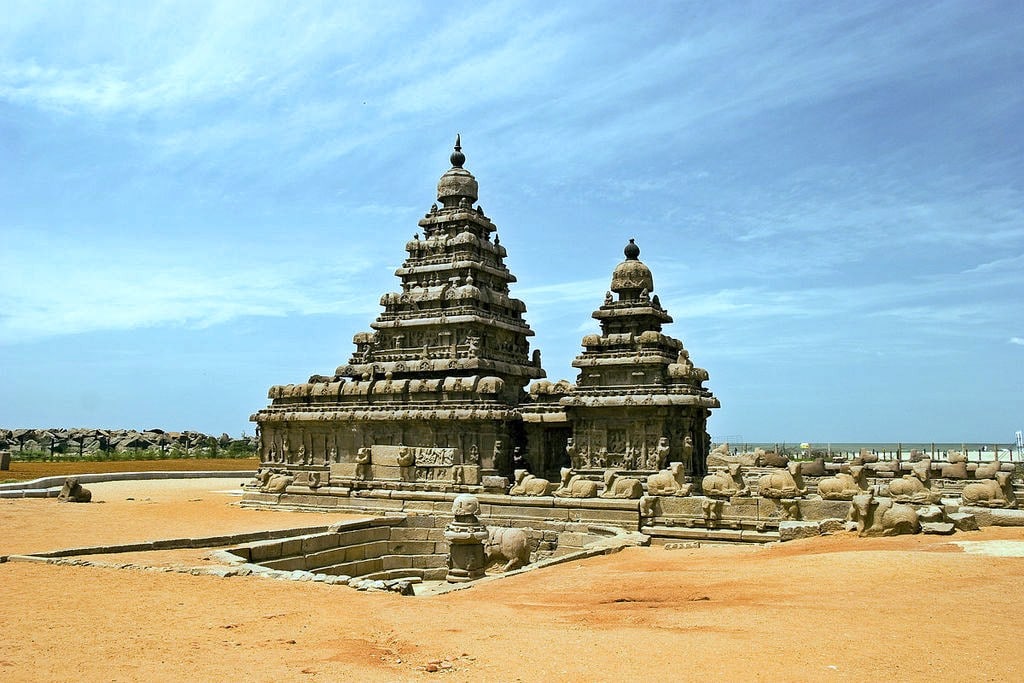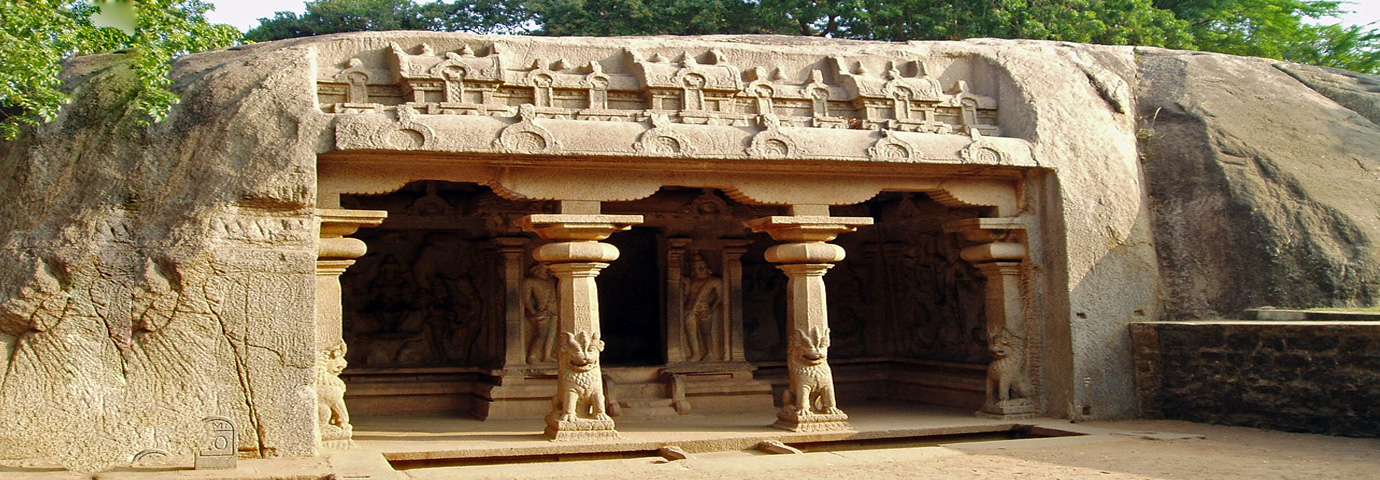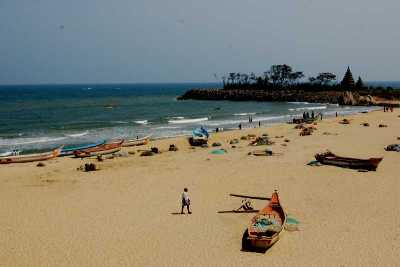Places to visit in Mahabalipuram
Mahabalipuram is a small town with vibrant history dates back to the Tamil Pallava dynasty in the 7th and the 9th century in South India. Famous for its rock carved temples,sculptures and the world’s largest stone bas relief, The Group of Monuments of Mahabalipuram is granted the status of a UNESCO World Heritage Site.
Formerly a grand port city of the glorious empire of the Pallavas, Mahabalipuram now known as Mamallapuram is among the finest specimens of craftsmanship. The glorious days have mastered the art of construction without using bricks or mortar. Their exquisite sculptures from rocks are one of its kind and are the pioneer of many such masterpieces. The extravagant Shore Temple is an icon, associated with the glory of the days. This city is a place of ancient sculptural wonders. The structures here are mostly carved out of granite and are one of the oldest existing examples of the Dravidian architecture.
The world heritage site has other nine rock-cut cave temples with interesting carvings on the walls portrays scenes from the Hindu mythology and stories from Panchtantra. Awe at the finely-carved Hindu Gods and Goddesses in various postures, some mythological relating incidents. The most popular icon is the carving of the celebrated fight between Mahishasura and Goddess Durga and another carved image of Lord Vishnu and Lord Shiva.
Among the most impressive sights is the carving of the magnificient Pandava Rathas (dedicated to the Pandava brothers of Mahabharata) all carved out of a single rock. Another popular carving is known as Arjuna’s Penance or the Descent of Ganga where the Mahabharata hero was said to have paid for his worldly sins. There are also famous ‘Mandapams’,which are rock-cut galleries with sculpted figures inside them. The timeless setting of rocks by the serene sea pays tribute to the magnificence of the heritage site.

Shore Temple
The Shore Temple is so named because it overlooks the shore of the Bay of Bengal. It is located near Chennai in Tamil Nadu. It is a structural temple, built with blocks of granite, dating from the 8th century AD. At the time of its creation, the site was a busy port during the reign of Narasimhavarman II of the Pallava dynasty. As one of the Group of Monuments at Mahabalipuram, it has been classified as a UNESCO World Heritage Site since 1984. It is one of the oldest structural stone temples of South India. Shore temple is a complex of temples and shrines

Pancha Rathas
Five temples is a monument complex at Mahabalipuram, on the Coromandel Coast of the Bay of Bengal, in the Kancheepuram district of the state of Tamil Nadu, India. Pancha Rathas is an example of monolithic Indian rock-cut architecture. The complex was carved during the reign of King Narasimhavarman I: the idea of realising monolithic buildings, an innovation in Indian architecture, is attributed to this ruler. The complex is under the auspices of the Archaeological Survey of India and is part of the UNESCO World Heritage site inscribed by UNESCO as Group of Monuments at Mahabalipuram. Each of the five monuments in the Pancha Rathas complex resembles a chariot, and each is carved over a single, long stone or monolith, of granite which slopes in north-south direction with a slight incline. Though sometimes mistakenly referred to as temples, the structures were never consecrated because they were never completed following the death of Narasimhavarman I. The structures are named after the Ainthinai fame. In order of their size, they include the Shiva temple, Thirumal temple, Murugan temple, Indran temple, and Kotravai temple.

Descent of the Ganges
Descent of the Ganges is a monument at Mamallapuram, on the Coromandel Coast of the Bay of Bengal, in the Chengalpattu district of the state of Tamil Nadu, India. Measuring 96 by 43 feet, it is a giant open-air rock relief carved on two monolithic rock boulders. The legend depicted in the relief is the story of the descent of the sacred river Ganges to earth from the heavens led by Bhagiratha. The waters of the Ganges are believed to possess supernatural powers. The descent of the Ganges and Arjuna's Penance are portrayed in stone at the Pallava heritage site. The relief is more of a canvas of Indian rock cut sculpture at its best not seen anywhere in India. It is one of the Group of Monuments at Mamallapuram that were designated as a UNESCO World Heritage Site since 1984.

Krishna's Butter Ball
Krishna's Butterball is a gigantic granite boulder resting on a short incline in the historical coastal resort town of Mamallapuram in Tamil Nadu state of India. Since it is part of the Group of Monuments at Mamallapuram, a UNESCO World Heritage Site built during 7th- and 8th-century CE as Hindu religious monuments by the Pallava dynasty, it is a popular tourist attraction. It is listed as a protected national monument by the Archeological Survey of India

Group of Monuments at Mahabalipuram
The Group of Monuments at Mahabalipuram is a collection of 7th- and 8th-century CE religious monuments in the coastal resort town of Mahabalipuram, Tamil Nadu, India and a UNESCO World Heritage Site. It is on the Coromandel Coast of the Bay of Bengal, about 60 kilometres south of Chennai. The site has 40 ancient monuments and Hindu temples, including one of the largest open-air rock reliefs in the world: the Descent of the Ganges or Arjuna's Penance. The group contains several categories of monuments: ratha temples with monolithic processional chariots, built between 630 and 668; mandapa viharas with narratives from the Mahabharata and Shaivic, Shakti and Vaishna inscriptions in a number of Indian languages and scripts; rock reliefs; stone-cut temples built between 695 and 722, and archaeological excavations dated to the 6th century and earlier. The monuments were built during the Pallava dynasty. Known as the Seven Pagodas in many colonial-era publications, they are also called the Mamallapuram temples or Mahabalipuram temples in contemporary literature. The site, restored after 1960, has been managed by the Archaeological Survey of India.

Varaha Cave Temple
Varaha Cave Temple is a rock-cut cave temple located at Mamallapuram, on the Coromandel Coast of the Bay of Bengal in Kancheepuram District in Tamil Nadu, India. It is part of the hill top village, which is 4 kilometres to the north of the main Mahabalipurm sites of rathas and the Shore Temple. It is an example of Indian rock-cut architecture dating from the late 7th century. The temple is one of the finest testimonial to the ancient Hindu rock-cut cave architecture, out of many such caves also called mandapas. Part of the Group of Monuments at Mahabalipuram, the temple is a UNESCO World Heritage Site as inscribed in 1984 under criteria i, ii, iii and iv. The most prominent sculpture in the cave is that of the Hindu god Vishnu in the incarnated form of a Varaha or boar lifting Bhudevi, the mother earth goddess from the sea. Also carved are many mythical figures.

Mahabalipuram Beach
Also known as Mamallapuram by locals, the Mahabalipuram Beach is situated at a distance of 58 km from the Chennai city in Tamil Nadu. The beach lies on the shore of Bay of Bengal and comprises of some rock-cut sculptures which are pleasing to the eyes. It is also famous for caves, massive rathas, chariots and temples which offer a great spot for holiday. The Mahabalipuram beach is a perfect place to relax and give yourself a break from the deadlines and work pressure on a daily basis. People from near and far flock to the beach especially to enjoy the natural sunbathing offered by the beach. The windsurfers and swimming lovers are bound to have an amazing time at the beach for they are seen doing just that on the shores of the beach.

Alamparai Fort, Mahabalipuram
Many do not know the significance of the captivating fort as this long forgotten trading post is spoken about quite infrequently. In fact, the fort was listed in the International Tourism Fair in Berlin as one of the twenty lesser known tourist attractions in Tamil Nadu by The Tamil Nadu Tourism Development Corporation (TTDC). No matter what the present condition of the Alamparai fort is, the view is sure to take your breath away. As you walk across the enthralling fort, you'll find surprising traces of life in the form of shrubs, creepers, bushes and trees even on the walls. It almost looks like they are supporting those parts of the structure and help them stand strong even today.

